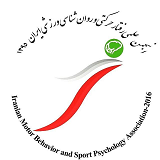Sun, Dec 28, 2025
[Archive]
Volume 4, Issue 3 (8-2022)
IJMCL 2022, 4(3): 10-15 |
Back to browse issues page
Download citation:
BibTeX | RIS | EndNote | Medlars | ProCite | Reference Manager | RefWorks
Send citation to:



BibTeX | RIS | EndNote | Medlars | ProCite | Reference Manager | RefWorks
Send citation to:
Sajedi L, Parsaie N, Biglari M, Sattarzade M H. (2022). Effect and Permanency of Core Stability Training on Static and Dynamic Balance in Blind Children. IJMCL. 4(3), 10-15. doi:10.52547/ijmcl.4.3.10
URL: http://ijmcl.com/article-1-124-en.html
URL: http://ijmcl.com/article-1-124-en.html
PhD Student, Department of Motor Behavior and Sport Psychology, Faculty of Physical Education and Sport Sciences, University of Tehran, Tehran, Iran , morteza_beglary@yahoo.com
Abstract: (4310 Views)
Background: Maintaining balance is an important factor in blind people. The aim of the present study was to investigate the effects and permanency of core stability training on static and dynamic balance in the blind.
Methods: In Sepideh Norouzi School for the blind in Kermanshah, among the available students, 30 blind male and female students were selected and randomly divided into two groups: control (mean age: 9.81 years) and experimental (mean age: 9.7 years) groups. Firstly, static and dynamic balance were measured using Bess & Y balance tests respectively. Then, the experimental group performed core stability training for 8 weeks and 3 sessions per week (15 to 20 minutes per session). Static and dynamic balance tests were performed again after the end of the training and also two months later.
Results: Findings using repeated measures analysis of variance showed that core stability training, immediately after training had significant positive effects on static (p= 0.005) and dynamic (p= 0.001) balance. Also, two months after the end of the training, the positive effects of the training on static (p= 0.009) and dynamic (p= 0.012) balance were significant.
Conclusions: Based on this, it can be said that core stability training can be used to strengthen static and dynamic balance, with long-term effects in blind people. Therefore, it is recommended that trainers pay attention to these training to improve balance in the blind.
Methods: In Sepideh Norouzi School for the blind in Kermanshah, among the available students, 30 blind male and female students were selected and randomly divided into two groups: control (mean age: 9.81 years) and experimental (mean age: 9.7 years) groups. Firstly, static and dynamic balance were measured using Bess & Y balance tests respectively. Then, the experimental group performed core stability training for 8 weeks and 3 sessions per week (15 to 20 minutes per session). Static and dynamic balance tests were performed again after the end of the training and also two months later.
Results: Findings using repeated measures analysis of variance showed that core stability training, immediately after training had significant positive effects on static (p= 0.005) and dynamic (p= 0.001) balance. Also, two months after the end of the training, the positive effects of the training on static (p= 0.009) and dynamic (p= 0.012) balance were significant.
Conclusions: Based on this, it can be said that core stability training can be used to strengthen static and dynamic balance, with long-term effects in blind people. Therefore, it is recommended that trainers pay attention to these training to improve balance in the blind.
Full-Text [PDF 893 kb]
(1268 Downloads)
- The stability of the middle girdle of the body is important in the blind.
- Core stability training improves static and dynamic balance in the blind.
- The beneficial effects of core stability training on balance can be sustained.
- Educators can use core stability training to maintain the balance of the blind.
Type of Study: Original Article |
Subject:
2. Motor control
Received: 2022/03/17 | Accepted: 2022/07/13
Received: 2022/03/17 | Accepted: 2022/07/13
References
1. Ayvazoglu, Nalan R., Hyun-Kyoung Oh, and Francis M. Kozub. 2006. "Explaining Physical Activity in Children with Visual Impairments: A Family Systems Approach." Exceptional Children 72(2): 235-48. http://journals.sagepub.com/doi/10.1177/001440290607200207. [DOI:10.1177/001440290607200207]
2. Carty, Christopher P. et al. 2015. "Reactive Stepping Behaviour in Response to Forward Loss of Balance Predicts Future Falls in Community-Dwelling Older Adults." Age and Ageing 44(1): 109-15. https://academic.oup.com/ageing/article-lookup/doi/10.1093/ageing/afu054. [DOI:10.1093/ageing/afu054]
3. Çolak, Tuncay et al. 2004. "Physical Fitness Levels of Blind and Visually Impaired Goalball Team Players." Isokinetics and Exercise Science 12(4): 247-52. https://www.medra.org/servlet/aliasResolver?alias=iospress&doi=10.3233/IES-2004-0182. [DOI:10.3233/IES-2004-0182]
4. Cote, Karen P., Michael E. Brunet, Bruce M. Gansneder, and Sandra J. Shultz. 2005. "Effects of Pronated and Supinated Foot Postures on Static and Dynamic Postural Stability." Journal of Athletic Training 40(1): 41-46.
5. Dastjerdi Kazem M. 2001. 2 The Base Motor Skills in Children with Intellectual Disability. Except Child.
6. Hallahan, Daniel, and James M. Kauffman. 1991. Exceptional Children: Introduction to Special Education 5th Edition. Allyn & Bacon.
7. Hodges, Paul W, and Carolyn A Richardson. 1997. "Contraction of the Abdominal Muscles Associated With Movement of the Lower Limb." Physical Therapy 77(2): 132-42. https://academic.oup.com/ptj/article/2633127/Contraction. [DOI:10.1093/ptj/77.2.132]
8. Ignacio, Teresita Dinoc. 2020. "LATIN AEROBICS: AN EXERCISE WORK-OUT FOR STATIC AND DYNAMIC BALANCE OF CONGENITALLY BLIND CHILDREN." Erudio Journal of Educational Innovation 7(1): 48-56. https://erudio.ub.ac.id/index.php/erudio/article/download/342/256. [DOI:10.18551/erudio.7-1.4]
9. Jazi, Shirin Davarpanah, Fatemeh Purrajabi, Ahmadreza Movahedi, and Shahin Jalali. 2012. "Effect of Selected Balance Exercises on the Dynamic Balance of Children with Visual Impairments." Journal of Visual Impairment & Blindness 106(8): 466-74. http://journals.sagepub.com/doi/10.1177/0145482X1210600803. [DOI:10.1177/0145482X1210600803]
10. Jeffreys, Ian. 2002. "Developing a Progressive Core Stability Program." Strength and Conditioning Journal 24(5): 65-66. http://journals.lww.com/00126548-200210000-00017. [DOI:10.1519/00126548-200210000-00017]
11. Juodzbaliene, Vilma, and Kazimieras Muckus. 2006. "The Influence of the Degree of Visual Impairment on Psychomotor Reaction and Equilibrium Maintenance of Adolescents." Medicina (Kaunas, Lithuania) 42(1): 49-56.
12. Kibler, W Ben, Joel Press, and Aaron Sciascia. 2006. "The Role of Core Stability in Athletic Function." Sports Medicine 36(3): 189-98. http://link.springer.com/10.2165/00007256-200636030-00001. [DOI:10.2165/00007256-200636030-00001]
13. Mahrokh Moghadam A, Zarei M, Mohammadi F. 2017. "The Effect of Central Stability Exercises on the Fitness of the Athletes of Gulbal Elite." Sports Medicine 10(23): 47-61.
14. Mansfield, Avril et al. 2015. "Does Perturbation-Based Balance Training Prevent Falls? Systematic Review and Meta-Analysis of Preliminary Randomized Controlled Trials." Physical Therapy 95(5): 700-709. https://academic.oup.com/ptj/article/95/5/700/2686424. [DOI:10.2522/ptj.20140090]
15. Mansoori, Mohammad Hani, Yousof Moghadas Tabrizi, Mohammad Karimizadeh Ardakani, and Mitra Omidi. 2021. "The Effect of 4-Weeks Perturbation Training on Balance, Movement Function, and Risk of Falling in Blind People." Scientific Journal of Rehabilitation Medicine 10(3): 588-603. http://medrehab.sbmu.ac.ir/article_1101214.html?lang=en. [DOI:10.32598/SJRM.10.3.17]
16. Mavrovouniotis, Fotios I. et al. 2013. "The Effect of a Combined Training Program with Greek Dances and Pilates on the Balance of Blind Children." Journal of Physical Education and Sport 13(1): 91-100.
17. McCaskey A. 2011. "The Effects of Core Stability Training on Star Excursion Balance Test and Global Core Muscular Endurance."
18. Mirzadeh, Massoumeh, Mehrdad Fathi, Seyyed Reza, and Attarzadeh Hosseini. 2017. "Effect of Rock Climbing on Cervical Vestibular Evoked Myogenic Potential, Balance, Body Composition, and Functional Index in Congenitally Blind and Sighted Girls." Auditory and Vestibular Research 26(4): 231-39. http://avr.tums.ac.ir.
19. Moffa, Stefano et al. 2017. "Acute Effect of Whole Body Vibration on Balance in Blind vs. No-Blind Athletes: A Preliminary Study." Sport Sciences for Health 13(2): 323-29. http://link.springer.com/10.1007/s11332-017-0361-x. [DOI:10.1007/s11332-017-0361-x]
20. Nagy, Edit et al. 2007. "Postural Control in Elderly Subjects Participating in Balance Training." European Journal of Applied Physiology 100(1): 97-104. http://link.springer.com/10.1007/s00421-007-0407-x. [DOI:10.1007/s00421-007-0407-x]
21. Nikravan, A., Gholami Shahabi, A., Karimi, N. 2016. "The Effect of Combined Balance and Core Stabilization Progressive Training on Balance in Older Patients with Parkinson's Disease." Journal of Exercise Science and Medicine 8(2): 197-211.
22. Oldfield, R.C. 1971. "The Assessment and Analysis of Handedness: The Edinburgh Inventory." Neuropsychologia 9(1): 97-113. https://linkinghub.elsevier.com/retrieve/pii/0028393271900674. [DOI:10.1016/0028-3932(71)90067-4]
23. Omidi, Mitra, Ali Shamsi Majalan, and Mohammad Karimizadeh Ardakani. 2019. "Effect of Six Weeks of Vestibular Stimulation Exercises on the Balance and Motor Function of the Blind." Scientific Journal of Rehabilitation Medicine 9(3): 123-30.
24. Plisky, Phillip J et al. 2009. "The Reliability of an Instrumented Device for Measuring Components of the Star Excursion Balance Test." North American journal of sports physical therapy : NAJSPT 4(2): 92-99. http://www.ncbi.nlm.nih.gov/pubmed/21509114%0Ahttp://www.pubmedcentral.nih.gov/articlerender.fcgi?artid=PMC2953327.
25. Rajabi, Siavash, Bijan Goodarzi, and Maryam Mazidi. 2017. "The Comparison Effects of Eight Weeks Spark and Frenkel Exercises on Static and Dynamic Balance in the Blinds." hormozgan medical journal 20(6): 401-6. http://hmj.hums.ac.ir/article-1-1657-en.html. [DOI:10.18869/acadpub.hmj.20.6.401]
26. Ray, Christopher T. et al. 2008. "The Impact of Vision Loss on Postural Stability and Balance Strategies in Individuals with Profound Vision Loss." Gait & Posture 28(1): 58-61. https://linkinghub.elsevier.com/retrieve/pii/S0966636207002548. [DOI:10.1016/j.gaitpost.2007.09.010]
27. sadeghi, S., mahdavinezhad, R., Kamali, A. 2016. "Effectiveness of Core Stabilization Exercises on Balance and Gait Speed of Blind Students." Journal for Research in Sport Rehabilitation 4(7): 21-30.
28. Shinya, Masahiro et al. 2011. "The Effect of Choice Reaction Task on Impact of Single-Leg Landing." Gait & Posture 34(1): 55-59. https://linkinghub.elsevier.com/retrieve/pii/S0966636211000889. [DOI:10.1016/j.gaitpost.2011.03.011]
29. Smail KM, Horvat M. 2005. "Effects of Balance Training on Individuals with Mental Retardation." Clin. Kinesiol 59(3): 43-47.
30. Soares, Antonio Vinicius et al. 2011. "Postural Control in Blind Subjects." Einstein (São Paulo) 9(4): 470-76. http://www.scielo.br/scielo.php?script=sci_arttext&pid=S1679-45082011000400470&lng=en&tlng=en. [DOI:10.1590/s1679-45082011ao2046]
31. Sonthikul, Chatwalai et al. 2019. "Comparative Effect of a Balance Training Program and Core Stabilization Program on Factors Related to the Prevention of Falling in Healthy Middle-Aged Individuals: A Double-Blind Randomized Controlled Clinical Trial." Journal of Health Science and Medical Research 37(3): 171-81. http://www.jhsmr.org/index.php/jhsmr/article/view/50. [DOI:10.31584/jhsmr.201950]
32. Veqar, Zubia. 2014. "Methods of Postural Assessment Used for Sports Persons." JOURNAL OF CLINICAL AND DIAGNOSTIC RESEARCH. http://www.jcdr.net/article_fulltext.asp?issn=0973-709x&year=2014&volume=8&issue=4&page=LE01&issn=0973-709x&id=4266.
33. Woollacott, Marjorie, and Anne Shumway-Cook. 2002. "Attention and the Control of Posture and Gait: A Review of an Emerging Area of Research." Gait & Posture 16(1): 1-14. https://linkinghub.elsevier.com/retrieve/pii/S0966636201001564. [DOI:10.1016/S0966-6362(01)00156-4]
Send email to the article author
| Rights and Permissions | |
 |
This work is licensed under Attribution 4.0 International (CC BY 4.0). |












